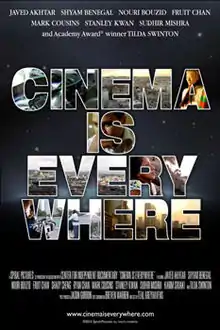Cinema Is Everywhere
Cinema is Everywhere is a 2011 documentary film by writer, director and cinematographer Teal Greyhavens that weaves together three stories from India, Scotland and Tunisia, each featuring personal perspectives on the effects of local, regional and international cinema on people's lives. It is based around the idea that cinema is a universal visual language that people of almost any culture can enjoy and even create regardless of where they are, who they know or how much money they have. It has been called "the global story of cinema and how it affects our everyday lives."[1] The documentary was filmed by Greyhavens in 2009 while he traveled on a Thomas J. Watson Fellowship.
| Cinema is Everywhere | |
|---|---|
 | |
| Directed by | Teal Greyhavens |
| Produced by | Jason Gordon |
| Written by | Teal Greyhavens |
| Starring | Javed Akhtar Shyam Benegal Nouri Bouzid Fruit Chan Mark Cousins Stanley Kwan Sudhir Mishra Tilda Swinton |
| Music by | Brandon K. Verrett |
| Cinematography | Teal Greyhavens |
Production company | Spiral Pictures |
| Distributed by | TriCoast Worldwide |
Release date |
|
Running time | 86 minutes |
| Country | United States |
| Language | English Mandarin Chinese |
Synopsis
The film follows real-time stories of actors, directors and cinema viewers in four different countries. In Tunisia, a documentary film director struggles to have his frank film about human sexuality be seen in their conservative culture. In India, a young actress struggles with the challenges of making a name for herself while dealing with racist barriers. And in Scotland, actress Tilda Swinton and filmmaker Mark Cousins, create a film festival that travels to audiences rather than having the audiences come to the festival. These stories jump back and forth as the narratives develop, interspersed with scenes from video stores, projection booths and homes of all kinds. Toward the end of film there are brief commentaries by Indian film director Sudhir Mishra and Chinese director Fruit Chan.
Reception
The film premiered at the Austin Film Festival on October 22, 2011, and received an enthusiastic reception. One reviewer called it "a love letter to the joy, beauty, pain and importance of a tool and art form that in 24 frames per second can express our deepest hopes and fears and connect us all."[2] It was screened a month later at the Costa Rica International Film Festival. In January 2012, it was seen at the Jaipur International Film Festival in Jaipur, India.
References
- Knegt, Peter. ""Cinema is Everywhere" Director Teal Greyhavens On His "quasi-academic project"". Retrieved 2012-01-10.
- Odam, Matthew. "AFF Capsule Review: 'Cinema is Everywhere'". Retrieved 2012-01-10.
